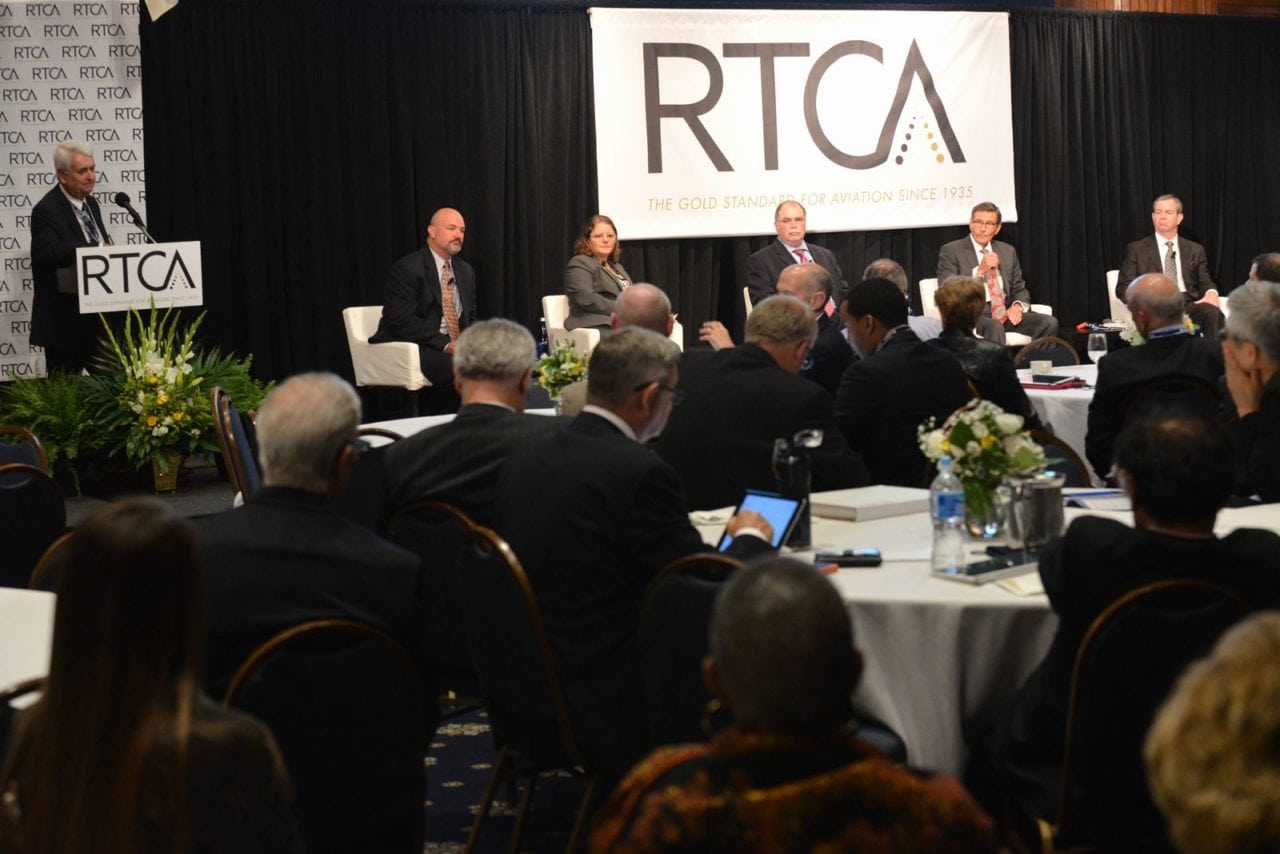[Avionics Magazine 06-02-2016] The 2016 annual RTCA symposium began Wednesday, June 1, with a panel discussion featuring pilot, air traffic controller, avionics manufacturing and research and development perspectives from the NextGen Advisory Committee (NAC). Members of the panel provided in-depth evaluations on the benefits that operators are realizing with NextGen initiatives, such as Data Comm and Performance-Based Navigation (PBN), and how these benefits stack up against the challenges of equipping aircraft to participate in the concept of operations plan that the FAA has laid out for NextGen.
 |
| The 2016 annual RTCA 2016 Global Aviation Symposium opening panel. Photo: RTCA Symposium |
Jeff Martin, executive vice president of operations for JetBlue, noted how airlines are investing in new technology to fly within the NextGen concept of operations. According to Martin, all 219 of JetBlue’s Airbus and Embraer passenger jets are equipped to fly PBN flight procedures. That equipage helped the airline to mitigate the impact of a major runway closure that they and other airlines had to navigate at John F. Kennedy (JFK) International Airport earlier this year.
“We had made the decision to equip 100 percent of the fleet with PBN capabilities, and then we went to the controllers and said every aircraft that comes into JFK for JetBlue is capable of flying the [Required Navigation Performance] RNP approach. That made it easier for the controllers because they didn’t have to filter out, and we saw our usage rate literally go from the hundreds to the thousands. It was repetitive; it was predictable; it was a situation where we negated mixed equipment and then saw success,” said Martin.
Martin also discussed some of the challenges JetBlue is experiencing with modifying some of the older aircraft within its fleet for certain NextGen initiatives, such as the FAA’s upcoming mandate that requires aircraft flying in the U.S. National Airspace System (NAS) equip with Automatic Dependent Surveillance Broadcast (ADS-B) Out technology. Over the last year, JetBlue has also focused on what equipment modifications its aircraft will need to operate under the NextGen DataComm program, which is currently in its earliest Departure Clearance (DCL) phase.
“We will be installing ADS-B Out and we will be pursuing space-based ADS-B capability. We’ll be putting [satellite communications] satcom on our aircraft and then we have a lot of work to do around the [Multi Mode Receivers] MMRs to make sure we have GPS availability — and there are some challenges around that. And then, more importantly, we have shifted our investment to Data Comm. The dollar will follow the benefit,” said Martin. “Short-term benefit for us will be DataComm; we will continue to invest … with space-based ADS-B. I see that as the future; we want to see that occur.”
Regarding space-based ADS-B, Aireon provided a major update on the global air traffic surveillance network it is developing on the same day that Martin mentioned JetBlue’s interest in the technology. Harris Corp. has completed production of all 81 ADS-B 1090 Extended Squitter receiver payloads that will be incorporated into the Iridium Next satellites to operate a global space-based ADS-B system.
Aireon has announced agreements with several Air Navigation Service Providers (ANSPs) that are committed to using the system in their airspace. So far, the FAA is not one of them, however. At least one version of an FAA reauthorization bill released by the Senate in March would require the FAA to ensure that its existing ATC system would have the ability to receive space-based ADS-B data.
Also featured on the panel discussion was Peter Dumont, president and CEO of the Air Traffic Control Association (ATCA), who believes one of the major challenges for the NextGen program going forward will be cybersecurity and risks associated with introducing new air-to-ground communications capabilities. Carl Esposito, vice president of marketing and product management at Honeywell Aerospace, was also on the panel and addressed cybersecurity as well as equipage challenges associated with modifying aircraft to fly in the NextGen airspace.
“One of the unique things in aviation is that we fundamentally think about safety and security and segregation when we design aircraft [and] when we design the systems, in terms of different hazard levels, different certification levels. That is built into our DNA in terms of the aviation community. Certain systems can’t talk to each other, certain systems can only talk one way and not two ways, so we’ve built a lot of that into our system architectures aviation-wise. Now, as we introduce new technologies into the aircraft around iPads or non-certified devices we need to ensure that we’re continuing to have that type of vigilance from a technology perspective,” said Esposito.
Esposito also noted that one of the ways Honeywell and other avionics manufacturers are addressing equipment upgrades and aircraft modification going forward is to enable more software upgrades that support new capabilities rather than requiring major aircraft downtime for hardware changes.
Finally, Air Line Pilots Association (ALPA) International President Tim Canoll discussed some of the greatest challenges pilots are facing in flying NextGen PBN procedures. One issue that continues to plague pilots is that Flight Management Systems (FMS) on a lot of in-service aircraft have difficulty keeping up with new procedures as they are introduced. Even though FMS navigation databases are updated every 28 days, there are still procedural and technical glitches with picking up some of the new approaches being deployed into different airports.
“We’re seeing procedures come to us in the cockpit that our aircraft are not capable of doing. I see it all the time: I’ll read a [Notice to Airmen] NOTAM going into Houston and it says ‘Do not connect the runway to the approach because if you do, your FMS will go blank and you’ll be essentially a 727 flying [VHF Omni Directional Ranges] VORs, radios and headings from air traffic control and once you get your box back, don’t connect it to the runway.’ That’s an example of where the procedures have outpaced our equipage,” said Canoll.